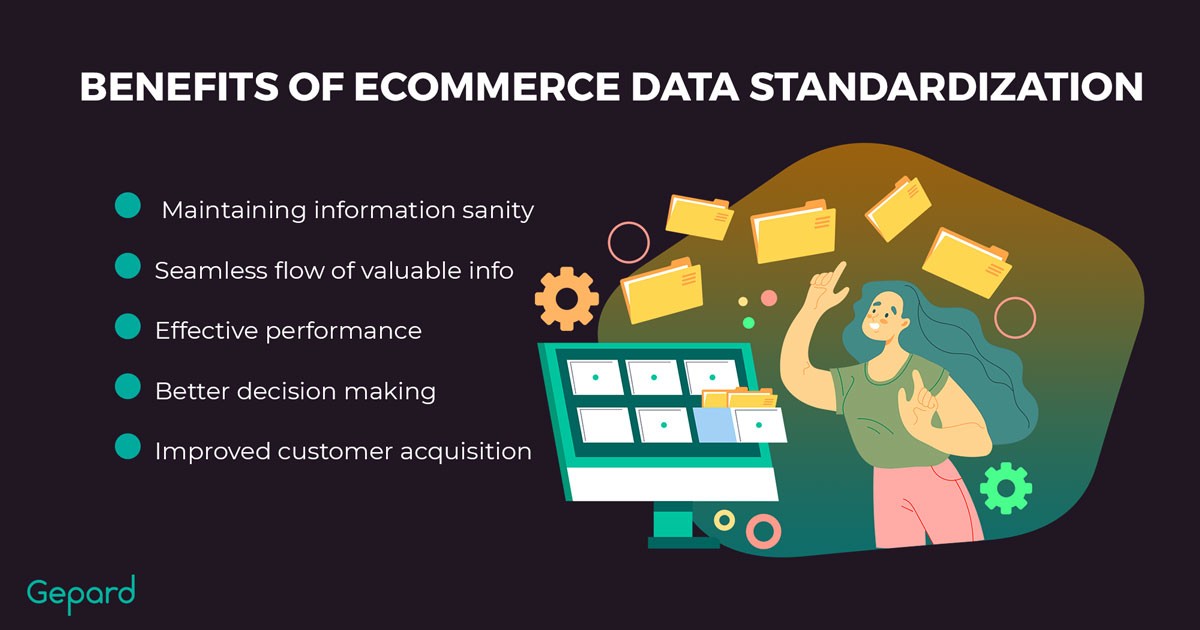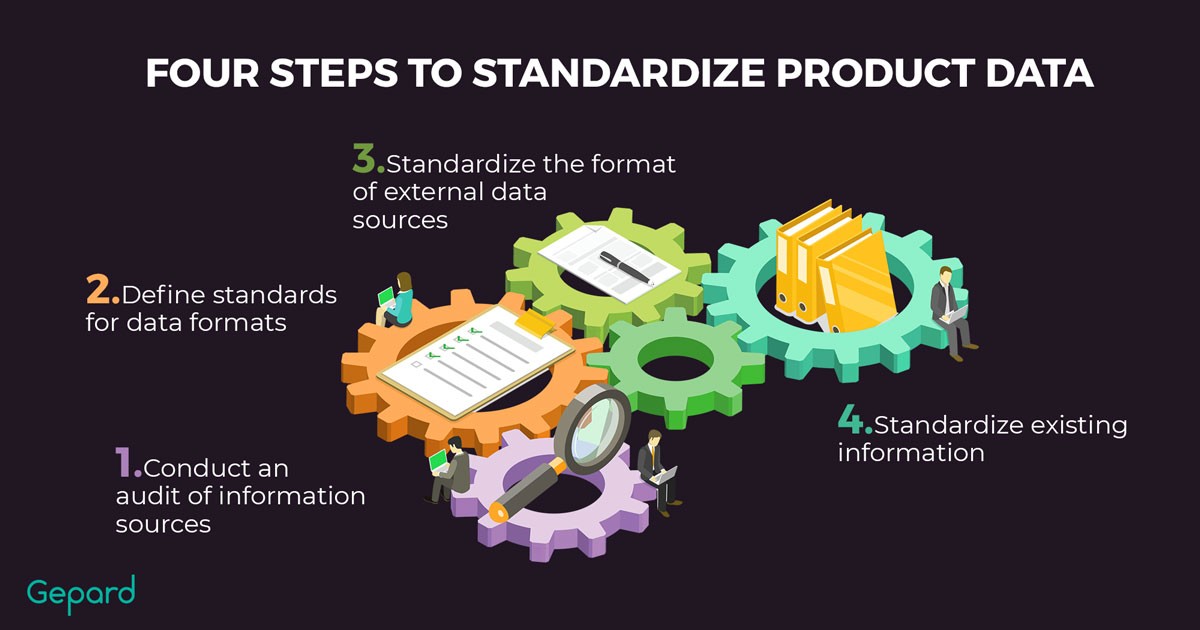Understanding eCommerce Data Standardization: Challenges And Best Practices
eCommerce data standardization is one of the things that keeps an eCommerce business up and running. Especially if there are a lot of suppliers, consumers, and several sales channels. In this article, we will explore this process in detail, as well as ideas on how to manage it properly. Let’s start with an answer to the main question — what is eCommerce data standardization?
What Is eCommerce Data Standardization?
Benefits Of eCommerce Data Standardization
Standardization of product data offers a set of benefits. Some of them are:
Maintaining Information Sanity
A standardized database helps to keep track of important, relevant, and insignificant information. Thus, you can prioritize it so that users don’t get distracted and instead focus on useful content. With this feature, users will be able to focus on what matters most to them: if they are buying a book — on a genre, and if they are looking for a TV — on screen size.
Seamless Flow Of Valuable Info
Standardized data makes the life of your business easier and better managed. Not only does it reduce the workload of some departments by introducing a uniform system of content format but also speeds up the working process thanks to prioritization. A bright example is workers’ productivity change and time distribution. People who have a unique content format work faster. They spend less time performing routine tasks and can do more during the same eight working hours.
Effective Performance
eCommerce data standardization also helps to keep a high level of product data quality. You can see exactly what kind of details about specific items you need to improve or add. For example, you know exactly that your section with belts lacks information about the materials used. This means that you should add it as soon as possible so that your customers are aware of all the characteristics.
Facilitates Better Decision Making
One of the main things customers need to make a purchase decision is relevant information. And you can help them by providing it in a format that users are familiar with. Thus, you facilitate their decision-making and gain customers’ trust and interest. For example, add comparison tables or sections, and size charts — these details will be extremely useful and give a store an edge over competitors.
Improves Customer Acquisition
By standardizing your website’s information, users are more likely to be converted into customers. Imagine you are a customer and have to decide between two websites, where the first offers one single format of the information, and the other presents different formats. Where would you most likely make a purchase, or even start looking for the products? The answer is obvious.

Five Challenges Affecting Product Data Standardization
When starting the implementation of product data standardization, your business may face various challenges.
1. Asymmetry In Seller Content
One of the biggest advantages of modern online marketplaces is that they are open to local, native sellers. And there is no problem until these sellers start using native words or names. It is okay for local markets but can become a big issue in an international market. Some native product names may mean something offensive or rude when translated, which can lead to a decrease in sales and other negative consequences for both sellers and the marketplace.
2. Manufacturer’s Product Descriptions
To increase visibility and product rankings, manufacturers and sellers write all kinds of descriptions. Sometimes, their “unique” descriptions can be a reason why customers can’t find an item through search engines.
3. Deviation In Units Of Measurement
When it comes to selling on a global online marketplace, the metrics that sellers use matter. The EU, the USA, the UK, Asia, and India — all have different units of measurement for clothing (cm, inches), weight (kg, pounds), and even temperature (Kelvin, Fahrenheit). By mentioning just one unit of measurement, sellers can cut themselves from customers unfamiliar with it. It is also important to let people convert one unit to another or set specific measurement units based on the country the main target audience comes from.
4. Formats Followed In Product’s Country of Origin
This challenge is similar to the previous one. As different countries have different standards for producing the same goods, this can become a big issue for customers. Buying jeans from a UK seller, customers from other countries will have to convert the sizing. This can affect a customer’s experience and their buying decision as well.
5. Legal And Global Requirements (ETIM, EPREL, GDSN)
Recently, different countries have developed special legal networks and systems to keep track of online sellers and their products in specific countries – ETIM, EPREL, and GDSN, for example. These networks have various distinctive features, including the countries they operate in. Read on to find a detailed explanation of each of them.

Product Data Standardization Best Practices
As you can see, there are a lot of challenges you may come across. However, with the right approach, you can complete the product data standardization process. Read on to find out how to do it right.
1. Product Data To Standardize
First of all, there are several types of product info to standardize.
- Commercial records. This is all information that can help a customer find what they are looking for through search engines, including articles, names, models, and prices. For example, the iPhone 10 search as the name of the model.
- Classification records. This type of information helps a customer find a suitable product among many similar ones. It covers color, size, and additional features. For example, iPhone 12 Pro graphite.
- Characteristics. This information relates to the product’s composition and properties. For example, iPhone 8 is equipped with a fingerprint scanner and iPhone 12 — with face recognition.
- D-U-N-S and TIN number correction. Data Universal Numbering System (D-U-N-S) is a unique nine-digit code that contains all information about business in a special network. Tax Identification Number (TIN) is a special code that clarifies if a seller or a manufacturer pays all taxes required. For example: 9xx-xx-xxxxx.
- The origin of the product. This category of information refers to a product’s manufacture date, certificates, and licenses. For example, iPhone X is designed in California and assembled in China.
2. Most Recognized Standards To Apply
There are three most used standards you need to pay attention to:
- ETIM International. This is a standardized product data classification for technological products. Manufacturers and sellers can exchange product information using a uniform datapool.
- EPREL. European Product Database for Energy Labeling is a system a manufacturer must register in to sell its products in the EU. By using it, any retailer/consumer can check if products can be sold legally in the EU, how eco-friendly they are, their quality, and whether they follow energy labeling regulations.
- GDSN. Global Data Synchronization Network is the world’s largest information network, which keeps product info registered there updated and standardized according to the GS1 standard.
3. Tools To Use For Data Standardization
Now it’s time to clarify how to standardize the data you already have. There are specific data standardization techniques, such as PIM product information management.
With the PIM system, you can unify all your information, setting it to the same format. You can also enrich it if you see that some positions lack details, giving your visitors accurate descriptions. The PIM also saves your workers from routine manual work, freeing up time for more important tasks.
Four Steps To Standardize Product Data
There are several steps you need to take in order to complete product data standardization.
Step 1: Conduct an audit of information sources.
You need to find out what the sources of information on your website are, how relevant they are, and whether they meet the requirements of your platform. For the first time, you can contact eCommerce data analysts who will help you do that professionally.
Step 2: Define standards for data formats.
Based on the results of the previous step, you need to choose what format suits your platform the most. The point is to have the same data format everywhere for everyone.
Step 3: Standardize the format of external data sources.
Start filtering your external data sources based on their relevance, importance, or other factors you deem necessary.
Step 4: Standardize existing information.
Use PIM to standardize all data you already have to one format.

How PIM Solutions Help For Product Data Standardization
Why use PIM? It helps you overcome some issues and can also provide valuable product experiences. The challenge sellers face to sell on various marketplaces is meeting the product taxonomy requirements applicable on different marketplaces.
Gepard PIM offers a sound solution to have the product data standardized and presented. We take the source taxonomy of a product content provider, may he be an independent provider of product information or a vendor, or both, bring it in line with the target taxonomy of the marketplace and deliver the data in the required format. In the process of transformation, the product content can be additionally enriched to provide the buyer with the product information as complete as possible.
Since Gepard PIM integrates and maps taxonomies of product data from different sources, we have developed a common taxonomy as a standard of data structure to which the system will bring any data taxonomy imported from an external source or created within the platform.
Here are some of the examples of the product data standardization Gepard PIM can help you with:
Product name formats
With PIM, you can choose popular and suitable name formats that will make your product easier to find on international marketplaces.
Attribute label and attribute value mapping
With PIM, you can check how your product will be displayed on online marketplaces, including its name and labels.
Measurement standardization
Use PIM to apply the same measurement system for all your products. In several clicks, all units of measurement will be converted into the one you chose.
Acronym or abbreviation expansion
The PIM system can also help you deal with acronyms and abbreviations. It means that your products could be found by both abbreviations and their full names without extra help or tools.
eCommerce Data Standardization FAQ
What Information Is Used In eСommerce?
Product attributes, consumer review, pricing, commercial, sales performance, as well as retail, customer, and POS data are used in eCommerce.
How Does Data Standardization Help Decision Making?
Standardized data help your customer find relevant information on desired products and proves the credibility of the platform. Remember, relevant and trustworthy content is a key to customers’ trust and potential purchase on a platform.
Why Are eCommerce Data Analysts Essential For Brands?
Some issues cannot be solved by brand managers. In such cases, external help is required. eCommerce data analysts can help a brand find a flaw in their system or give useful advice on how to improve an already existing system.
Why Does Your Business Need Standardization?
As the eCommerce market keeps expanding, every customer is valuable to companies. So, it is in their best interest to get as many clients as possible. Standardized data is a way to turn visitors into loyal customers. However, it is also a resource-intensive procedure, both time and moneywise. It may hinder you from concentrating on strategic, creative, and other kinds of goals you have. When you feel that you can’t keep track of all tasks together, get a PIM (Product Information Management) solution. Designed specifically to solve these problems, it will let you forget about monotonous work.
Changing all information to fit one common format is not an easy task, and you shouldn’t deal with it alone. Don’t be afraid to ask for help when you need it. Just contact us, and we will be there for you from the beginning till the end of this process.


